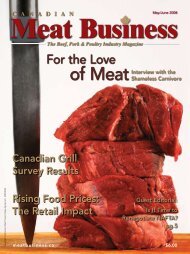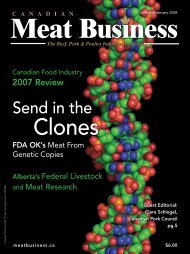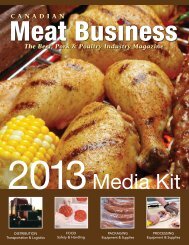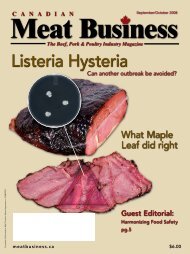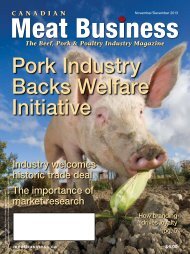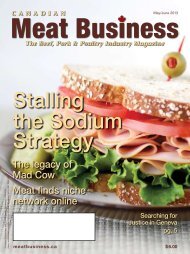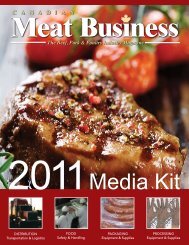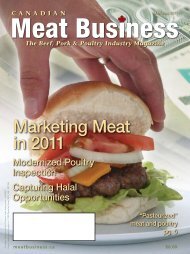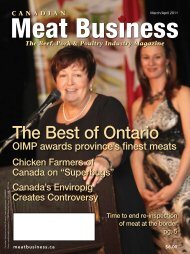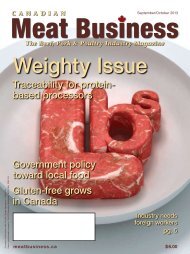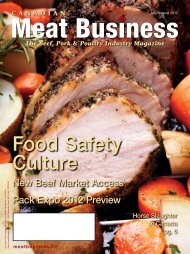Ralph Cator
Joining Meat Hall's Class of 2010 - Canadian Meat Business
Joining Meat Hall's Class of 2010 - Canadian Meat Business
You also want an ePaper? Increase the reach of your titles
YUMPU automatically turns print PDFs into web optimized ePapers that Google loves.
“Critical to the success of this new voluntary sodium reduction<br />
strategy is consumer acceptance,” Laws stated. “Consumers<br />
need to be aware of why the changes are occurring and they<br />
need to accept the changes in products for the strategy to be<br />
successful.”<br />
Laws also stressed that the meat industry is fully aware of the<br />
importance of reducing sodium intake in Canada.<br />
“Our members are committed to providing Canadians with<br />
sodium-reduced options – and have been for several years<br />
– evidenced by the many sodium reduced processed meat<br />
products already available to consumers in grocery stores,” he<br />
stated.<br />
Looking ahead<br />
According to Valade, the work of the SWG is far from over. She<br />
said she expects one of the next steps may be the development<br />
of a labelling system, similar to one used in the United Kingdom<br />
(which, she noted, inspired Health Canada to create the SWG).<br />
The U.K. system is based on using coloured traffic lights<br />
symbols to warn consumers of sodium levels – for example a<br />
product containing 1.25g of salt (or 0.5g sodium) is labelled red<br />
while 0.25g salt (0.1g sodium) is labelled green.<br />
“We’ll be looking at labelling options to support lower sodium<br />
products and at a review as to whether the targets recommended<br />
are in fact being met by industry,” she said.<br />
Some specific targets for sodium reduction have been set (see<br />
table) and more will be finalized in 2011. However, these targets<br />
will be re-established over time as progress toward the 2016<br />
interim goal is tracked.<br />
For more information on the Sodium Reduction Strategy and how it<br />
affects the meat industry, read Susan Evans’ article on page 30.<br />
Sodium Reduction Strategy's<br />
six overarching recommendations:<br />
• Interim intake goal of 2,300 mg of sodium/day by<br />
2016 – with a longer-term goal of 95 per cent of<br />
population with a daily intake below the UL.<br />
• Widespread collaboration across governments,<br />
health professional organizations, NGOs, media,<br />
industry and academia to implement the SWG’s<br />
full slate of recommendations.<br />
• Adequate federal/provincial/territorial funding to<br />
support the SWGs full slate of recommendations.<br />
• Integration of sodium reduction into government<br />
and stakeholder nutrition programs, guidelines<br />
and policies.<br />
• Implementation process to include identifying<br />
individual steps (including timelines) for each<br />
recommendation, as well as monitoring completion<br />
of each step.<br />
• Canadians take personal steps to reduce sodium<br />
consumption as part of a healthy diet.<br />
Targeted Recommendations in Four<br />
Areas:<br />
• Food supply<br />
• Awareness and education<br />
• Research<br />
• Monitoring and evaluation<br />
For more information, read the full report, Sodium<br />
Reduction Strategy for Canada, at www.hc-sc.gc.ca.<br />
Draft Targets for Meat Products<br />
The Sodium Working Group divided the food<br />
supply into two groups: Group I foods (combined<br />
contribute over 50% of the sodium in the diet) and<br />
Group II foods which includes the remaining food<br />
categories and restaurant and foodservice. Table 1<br />
compares the current average sodium content of<br />
the Group I meat products to the draft maximum<br />
sodium levels to be achieved by 2016.<br />
Categorization<br />
Sodium average<br />
mg/100g<br />
Maximum<br />
sodium level by<br />
2016 (mg/100 g)<br />
Uncooked Bacon - Belly and Back<br />
Bacon<br />
Fully Cooked Bacon - Breakfast<br />
Strips, Substitutes and Back Bacon<br />
Packaged Deli Meats - Pâtés and<br />
Spreads<br />
Packaged Deli Meats - excludes<br />
Pâté and Spreads<br />
Packaged Deli Meats – Dry Cured,<br />
Fermented, No Thermal Processing<br />
Uncooked Fresh Sausage -<br />
Breakfast and Dinner Varieties<br />
Fully Cooked Sausage - Smoked,<br />
Not Smoked and Wieners<br />
808.9 610<br />
1388.2 1150<br />
781.5 600<br />
1029.7 890<br />
1617.4 1400<br />
789.1 690<br />
992.7 870<br />
Data compiled by Mary Ann Binne based on label<br />
data and the proposed draft targets found at the<br />
Health Canada website (www.hc-sc.gc.ca).<br />
Canadian Meat Business September/October 2010<br />
meatbusiness.ca



